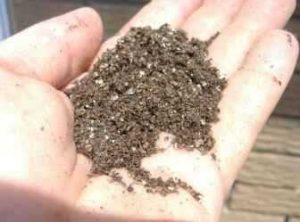Soil Improvement Additives by G Logan
I garden as organically as I can. It’s my choice to not only keep myself safe in the foods I grow and eat, but I try to keep the wildlife around me safe and the soil healthy.
It’s been my experience over many years that it’s more important to feed the soil and not the plant. So, I’m constantly on the watch for beneficial amendments.
In this article I’ll discuss the benefits of two soil improvers, mycorrhiza beneficial fungus and kelp or seaweed meal.
Mycorrhizal Beneficial Fungus Soil Additive
The most interesting item I’ve come across is a product which is 100% Mycorrhizal Fungi. Simply translated, it’s a beneficial fungus on a carrier. Still sounds unpleasant, doesn’t it?
In appearance, it resembles a coarse powder, brown in colour and completely safe to handle.
In function, the fungus associates with plant roots and increases phosphorus uptake, which in turn, stimulates root development. This better root development enhances plant growth.
Personally, I’ve used this product for several years and there is a definite abundance of feeder roots on plants where I’ve used this fungus. In fact, sometimes the root system is so thick that it’s almost difficult to pull out the plant, which is of considerable size itself.
Last year I used it under 3 Viva Italia paste tomato plants. Not only did I get an incredible crop from the 3 plants, but the roots had to be dug out with a shovel. Just wait until you try to pull out leek roots.
Application of this product couldn’t be simpler: at planting time, once you’ve dug the planting hole, add about 1 tablespoon of the mycorrhizal powder into the hole, place the plant roots directly on top, and fill with soil. If you like to add any fertilizers at this time, reduce the fertilizer to half the recommended amount. Personally, I add some bone & blood meal into the hole as well. If you’re running a furrow, add between 3 tbsp. to ½ cup of the fungus for every linear metre depending on the width of the furrow.
Shrubs and young trees also benefit from this fungus and the amount varies with plant size. My guess is that the various containers for bulbs, vegetables, trees & shrubs, and flowers differ only in the application amount and method used, otherwise the product is interchangeable.
Kelp (Seaweed) Meal
Another product which I’ve finally got hold of is Kelp Meal. I live inland with no access to seaweed, which is an excellent source of plant nutrient. Kelp provides essential micro-nutrients of vitamins, amino acids and hormones which promote strong cell structure and improves plant immunity. The latter is where I feel chemical fertilizers let plants down; they bloat the plant, not the soil, which make them a magnet for pests. Pests are rarely attracted to plants in healthy soil.
I find tomatoes and peppers benefit particularly from kelp meal, same with house plants. Again, the application is very simple: mix 1 tablespoon of kelp in 1 litre of hot water as a plant tea. Let the tea cool slightly before using as a foliar or ground feed. The powder can also be lightly sprinkled directly to the soil and scratched in. Planters benefit from 3 tbsp. of kelp.
Due to the rather high cost of kelp meal, it’s something I use only on specific plants as mentioned. I can’t see myself throwing it over the potato beds.
Powdered Sulphur to Lower pH
Powdered sulphur, sold by the pound, is a yearly purchase for me. Fairly inexpensive and easy to store in a lidded plastic juice container from the 99p (dollar) store, it’s also easy to dispense around rhododendron and blueberry bushes, then scratched in.
My soil is clay and a bit alkaline and these plants are definite acid lovers, so several times a season I add the sulphur and pull the mulch back on. My rhododendrons and blueberries have been in my garden 3 years now and they’re thriving.




